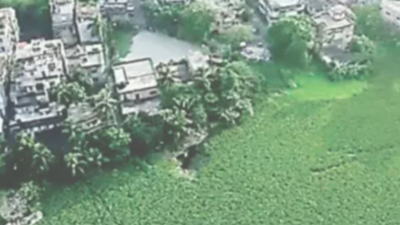Top Searches
- News
- City News
- kolkata News
- West Bengal grants Rs 2 crore to reverse EKW encroachment damage
West Bengal grants Rs 2 crore to reverse EKW encroachment damage

East Kolkata Wetlands
KOLKATA : The state environment department on Sunday — World Environment Day — allocated Rs 2 crore to reverse the biggest encroachment at the internationally recognised East Kolkata Wetlands (EKW) in the 20th year of it being declared a Ramsar site.
While courts have been ordering the restoration of bheris filled up by land sharks, this is the first time that funds have been set aside for restoring the encroached site back to the original condition.
TOI had reported the encroachment as well as the demolition of construction at the site.
The EKW, spread over 31,000 acres, plays a crucial ecological role. It is known as Kolkata’s ‘kidneys’, for the role it plays in purifying sewage water generated by the metropolis. “We have sanctioned the amount to Bidhannagar Municipal Corporation to excavate Bongheri Cheri, which had been illegally filled up,” environment department additional chief secretary Vivek Kumar said on Sunday.
The nearly 60-acre site in question in the Dhapa Manpur mouza, under the BMC, is spread across three contiguous bheris — Boro Bongheri, Chhoto Bongheri and Hara Singh Fisheries (more popularly called Rabi Ghosher Bheri, after the former owner). The original owners, Tapan Pandit and Rabi Ghosh, sold them around 2017-’18.
‘Implementation should be effective’
The gradual fill-up started from 2017-18 but gained momentum during the pandemic. After a member of the environmental action group, PUBLIC discovered the encroachment in 2020, a PIL was filed, followed by a court order this February on the razing of illegal constructions and restoration of the wetlands. “We are glad the government has recognised the importance of the wetlands,” said PUBLIC founder Bonani Kakkar.
It was another PIL that PUBLIC had filed three decades ago that led to a landmark judgment by Justice Umesh Chandra Banerjee that saved EKW from encroachment under the garb of development, and its subsequent protection. Dhruba Das Gupta, a wetlands researcher at IIEST Shibpur, hoped the government action would send a powerful message. “This is praiseworthy. The implementation should be quick and effective. ” The original count in 1997 had put the number of fully functional bheris at 264. In a revisit in 2014, the count had come down to around 200.
Green activists fear it may have dwindled further and called for a census. EKW officials said the restoration of the wetlands, if successful, would go a long way in bolstering efforts to prevent encroachment and conversion. “Preserving bheris is a challenge as people who want to convert the land into real estate are buying out bheris. Many people still don’t want to part with the bheris because they provide them with livelihood and decent profits. But there are several others who are being lured to sell,” the official said.
While courts have been ordering the restoration of bheris filled up by land sharks, this is the first time that funds have been set aside for restoring the encroached site back to the original condition.
TOI had reported the encroachment as well as the demolition of construction at the site.
The EKW, spread over 31,000 acres, plays a crucial ecological role. It is known as Kolkata’s ‘kidneys’, for the role it plays in purifying sewage water generated by the metropolis. “We have sanctioned the amount to Bidhannagar Municipal Corporation to excavate Bongheri Cheri, which had been illegally filled up,” environment department additional chief secretary Vivek Kumar said on Sunday.
The nearly 60-acre site in question in the Dhapa Manpur mouza, under the BMC, is spread across three contiguous bheris — Boro Bongheri, Chhoto Bongheri and Hara Singh Fisheries (more popularly called Rabi Ghosher Bheri, after the former owner). The original owners, Tapan Pandit and Rabi Ghosh, sold them around 2017-’18.
‘Implementation should be effective’
The gradual fill-up started from 2017-18 but gained momentum during the pandemic. After a member of the environmental action group, PUBLIC discovered the encroachment in 2020, a PIL was filed, followed by a court order this February on the razing of illegal constructions and restoration of the wetlands. “We are glad the government has recognised the importance of the wetlands,” said PUBLIC founder Bonani Kakkar.
It was another PIL that PUBLIC had filed three decades ago that led to a landmark judgment by Justice Umesh Chandra Banerjee that saved EKW from encroachment under the garb of development, and its subsequent protection. Dhruba Das Gupta, a wetlands researcher at IIEST Shibpur, hoped the government action would send a powerful message. “This is praiseworthy. The implementation should be quick and effective. ” The original count in 1997 had put the number of fully functional bheris at 264. In a revisit in 2014, the count had come down to around 200.
Green activists fear it may have dwindled further and called for a census. EKW officials said the restoration of the wetlands, if successful, would go a long way in bolstering efforts to prevent encroachment and conversion. “Preserving bheris is a challenge as people who want to convert the land into real estate are buying out bheris. Many people still don’t want to part with the bheris because they provide them with livelihood and decent profits. But there are several others who are being lured to sell,” the official said.
FOLLOW US ON SOCIAL MEDIA
FacebookTwitterInstagramKOO APPYOUTUBE
Looking for Something?

Start a Conversation
end of article

